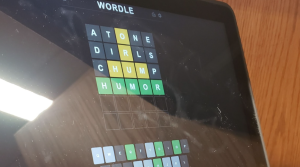Raptors Dance the Night Away
April 15, 2019
Salsa dancing is typically a traditional Cuban folk dance, although it is widely practiced in many Latin American countries as well. Salsa dancing has become a large part of Hispanic culture, and its origins are rich with history. Because of this, Claudia Camarena-Hackos, who teaches Honors Spanish at Eaglecrest, decided to teach some of her students how to perform the dance in class.
“The Salsa dance is part of teaching culture in a Spanish classroom. I think it is important to teach the importance of dancing in the Spanish-speaking world.” says Camarena-Hackos.
She says that students learned not only how to do the Salsa dance, but also learned how beauty is expressed through the arts. The class is currently covering the unit of Beauty, and learning to do the Salsa dance actively engaged students’ understanding of Beauty in Spanish culture.
“I think it did teach beauty, because although it looks simple, when done by experts it’s hard, so you appreciate their practice.” comments Aoife Rael, a student in the class who participated in the dance lessons.
It was a very enjoyable experience for the students and teacher alike.
“I think the students really enjoyed learning how to dance Salsa. I think they did a great job and I am positive they will continue to practice it now that they know how.” remarks Camarena-Hackos.
“The dance was really fun, but kind of difficult at first. My favorite parts were the turns, but I got really dizzy.” adds Rael.
But the challenge of learning such a dance was beauty in itself, and helped to show students why dance is so valued in spanish culture.
Camarena-Hackos is planning on teaching this dance to her Honors Spanish students again next year and for the years to come, due to its relevance within the Spanish culture and conveyance of beauty. It is a gateway for learning about a variety of spanish-speaking countries’ cultures, which is something that is very important to learn about when studying a new language.
“I think these traditions are influenced by the mixture of different types of people who celebrate their diversity. No matter which spanish-speaking country a person lives in, dancing is something that will be common for everyone.” add Camarena-Hackos.
Camarena-Hackos says she was very happy to see how much her students embraced learning the dance, and how well they performed it. She will continue to teach this wonderful dance, and students will be embraced with spanish culture that will nurture their understanding of the language that they’re learning, potentially leading them down the eventual path of fluency…all because they were exposed to such beauty, in the form of the Salsa dance.







